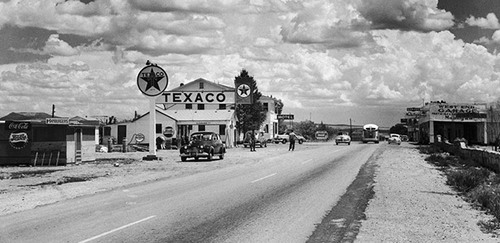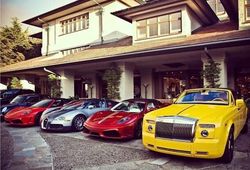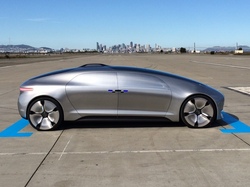CARS II:
Interesting topics related to the automobile:
There have been literally hundreds of brands of automobiles since 1895. Just look up "defunct US brands of automobiles" on the internet and you will see alphabetical lists of hundreds of brands gone by the wayside. I have listed the primary ones which have stopped production since WWII:
Kaiser-Frasier 1951 Crosley 1952
Nash 1954 Hudson 1954
Packard 1958 Edsel 1960
DeSoto 1961 Studebaker 1966
American Motors 1988
Eagle 1999 Plymouth 2001
Oldsmobile 2004 Pontiac 2010
Saturn 2010 Mercury 2011
Here are some others which were smaller specialty manufacturers which have also gone to the automobile graveyard. The list of defunce builders from before WW II would be 10 pages long and many other small companies since WW II would add several more pages:
Willy's 1963 Brecklin 1976
Delorian 1982 Geo 1997
Hummer 2010
Automobile Sales Charts:
www.markbayermotorcycles.mysite.com/whats_new.html
A Brief Developmental Timeline of the Automobile from 1900 to 2010:
(A.)From 1895 to 1905:
- during this time there were steam, electric and gasoline powered vehicles in roughly equal numbers
- the first automobiles were basically carts or carriages with an engine under the seat
- the first automobile was in 1899 held in NYC
- the first factories were being built
- the Duryea has been considered the first automobile manufactured for sale
- Duryea, Oldsmobile, Maxwell, Haynes, and Ford were the first larger manufacturers
(B.)From 1906 to around 1929:
- the automobile repaces the horse
- the basic design of the car is determined
- the gasoline car replaced steam and electric by 1908
- the Ford Model T becomes tha largest selling car of its time (nearly 50% of all cars were "T's")
- electric start begind in 1912
- people begin to travel farther distances
- by the mid 1920's over 70% of all cars were purchased through auto loans
- by the end of the 1920's most cars were closed rather than open
(C.)From 1930 to the pre WW II era (1944):
- Unions take over the industry and change the industry
- sales increase as the automobile is considered a necessity
- Packard experiments with the first air conditioner in 1941
- the depression kills many smaller manufacturers
- GM becomes the largest auto manufacturer in the US
- the automatic transmission begins to evolve being called "fluid drive"
- in 1932 Ford offers a V-8
- during the 1930's there is a move to destroy older cars which are in poor condition
(D.)From 1946 to around 1952:
- after WW II anything sells and for over list price
- first cars are warmed over pre war models but designs quickly change
- by 1950 new car sales exceed 6 million cars
- competition demands innovation
- Chrysler endures a 104 day strike in early 1950
- from the early 1950's, "fluid drive" transmissions are offered by larger companies
- by this time approximately 60% of all American families own a car
(E.) 1953 to 1963 introduces huge changes in the auto industry:
- nearly everyone offers an automatic transmission which now dominate in sales
- air conditioning becomes a popular option
- the flathead engine is prplaced by OHV engine almost exclusively
- the "dream car" era begins with factory customs being shown in the big car shows
- the horse power race begins
- the compact car emerges from 1960 (Corvair, Falcon, Valient, etc.)
- Hash & Hudson create American Motors
- Studebaker and Packare merge
- many small companies go out creating the big 3: GM, Ford, Chrysler
- in 1958 "window stickers" become a requirement with standardezed information
(F.) From 1964 to the 1990's:
- the muscle car emerges (big engines in mid sized cars) and are dead by the early 1970's
- Merce4des and BMW replace Lincoln and Cadillac as the premium cars
- by 1965 new car sales exceed 7 million annually
- Unions nearly bankrupt American manufacturers and have to give big concessions
- US brands loose market share and the Japanese brands gain exponentially in market share
- most Americans feel that the Japanese brands are better made than American brands
- in 1984 Chrysler creates the first computer designed car
- the government greatly increases limits on all cars (emissions, safety, and gas millage)
- by the late 1980's, front wheel drive cars begin to dominate
(G.) Since the end of the 1990's to today:
- Toyota becomes the largest car manufacturer in the world (2007)
- from the 1990's, GPS is first offered and becomes common
- by the late 1990's, hybrid cars emerge by all the largest companies
- 2006, both Chrysler and GM post losses so great that the federal government must bail them out
- all the American manufacturers copy Japanese designs and management styles
- ABS brakes move from a rarity to being commom
- the unions take over 18% of GM and cut salaries for employees
A Simple Overview of Car Clubs:
(A.) The first automobile clubs evolved from the early "wheel men" (or bicycle) clubs. These were "gentlemeans" type clubs which were intended to be exclusive groups in that the only the rich could afford a car.
(B.) The second phase of automobile clubs evolved during the 1930's in an attempt to "save" the early history of the automobile. Many groups like AAA found their beginnings during this time.
(C.) Thirdly, prior to WW II there were a few "enthusiast" oriented clubs which emerged. The SoCal salt flat groups are an example.
(D.) Fourth, after WW II the "hot rod" emerges and many clubs pop up related to this area of development.
(E.) Fifthly, from the early 1950's a new breed of club emerges. These clubs include custom cars, hot rods, classic cars, truck clubs, and an array of specialty groups associated with friends or types of cars.
(F.) Sixth, after the 1980's groups grow in size and the huge car shows begin. Clubs emerge around these developments.
(G.) Finally, since 2000, there has been an explosion of clubs covering specific brands, racing venues, closed groups of people, old cars of every vintage, and organizing shows and events.
The Cultural, Social, and Symbolic Elements of the Automobile as well as the Impact of Status Applied to Automobile Ownership:
From the beginning of automobile development, there has been great social change associated with it's development. The automobile has also been stood as a symbol of man's development and status, and has created numerous levels of status among man and society!
(I.) The automobile brought many social changes:
- the automobile allowed individuals and families to travel beyond what had been known before
- it has been documented that the ability for the farmer, by the use of better roads and cars/trucks, to sell his produce to an increasing audience revolutionized farming in the US
- the automobile created a "traveling salesman" revolution
- the automobile made the hotel/motel/roadside food businesses to be founded and to grow exponentially
- the automobile was behind the family vacation, or at least allowed it to happen with the masses
- the automobile revolutionized manufacturing and the the dominant companies became some of the largest companies in the world creating millions of jobs and building trillions in capitol
(II.) The automobile has been a symbol of mans achievements:
- the automobile was seen as one of man's crown achievement as a liberating machine
- it was believed that the machine, and the automobile epitimized the power of the machine, could make life easier and better
- the automobile and it's developments pointed to human progress
- the automobile pointed the way for other innovations such as the truck, the tractor, and thousands of new uses
(III.) The automobile has represented many different types of "status":
- humanity has always sought a means of appearing to be superior in some way, the automobile was a new avenue
- the automobile represented status, success, or wealth
- an automobile was a tangable way to show one's status
- the automobile has been considered an extension of a persons personality (the outward exemplifying the inward)
The Development of the Automobile Forced the Further Development of the American Road System:
America was a country known for it's bad roads. The bicycle brought the "good roads" movement around the late 1880's. The baton was passed from the bicyclist to the automobilist in demanding good roads. Although roads remained poor well into the late 1890's, there was a great deal of energy put into attempting to develop a plan for building good roads going forward. There is a great deal of history related to road building prior to the 1890's but this discussion will cover four defined stages of modern road development from just before 1900. For a brief discussion regarding roads in general check out the firsst three pages of this site. Noted below are the four general stages of road development which moved from disorganization to a clear system of road development. Note the following stages:
(I.) From around 1897 to 1917 (around the WW I period):
- this was the time period in which America switched from the horse to the automobile
- in 1901 there was only around 650 miles of paved road, nearly all roads were dirt, rock, or brick
- Portland cement began to be used around 1909
- most of the paved roads were aroend cities only
- in 1912 Congress had financed thousands of rural roads for mail service or for farmers
- the Lincoln Highway Association was formed in 1913
(II.) From 1918 to the WW II period (1942):
- paved roads begin to replace dirt and gravel roads by the thousands of miles
- by 1919 at least four states began taxing for road construction
- approximately 234,000 miles of paved roads were built during this time period
- President Hoover authorized $120,000,000 for road construction in 1932
- the Lincoln Highway was completed and additional cross country paved highways were built or were under construction
- Roosevelt's WPA in 1933 provided additional money for many roads
- police departments and highway patrols begin to emerge
(III.) From 1944 to 1956:
- the increased demand for roads increases financing, planning, and the construction of paved roads
- road construction could not keep up with the millions of new cars driving on the roads
- in 1937 the Public Roads Administration proposed a new system of interconnected interstate roads
- highway bills were passed in 1952, 1954, and 1955 further pressuring cities, states, and the nation as a whole to provide money for more paved roads
- the growth of suburbs in dozens of larger cities demanded additional roads beyond previous needs
(IV.) Roads since 1956:
- the Eisenhower interstate highway bill passes and ushers in a new era of roads
- roads were to be financed by gas, tire, oil, and truck taxes (highways were to be built as the money came in)
- the original interstate plan was completed in 1969 but additional needs were determined and development continued
- roads have grown wider with more bridges and overpasses
- as the original highways were passing through cities as they grew, city loops were built to ease traffic
- the cost of maintaining roads was greatly underestimated so the need for money continues
The highway system is never complete as cities grow and as suburbs increase. The original system not only requires resurfacing, but new entry/exit points, more bridges, widening, and more complex loops and junction points. There will be no end to the system which was started in 1956.
The Cult of Expensive and Fast Cars:
First, lets consider the element of "expensive" cars:
From the very beginning of automobile history fast and expensive cars have had a certain aura! A part of this tendency will be in the "bragging rights" provided or the assumed "exclusive" nature of the vehicle. The entire marketing strategy of the American automobile was to create a progressive or exclusive mage. You begin with the standard model, move up to the deluxe model, then have the limited edition model! After several years the limited edition will be placed under a new "Braughm" model which simply includes a little more chrome, contrasting seat fabric, and a glove box door medalian. In the early years manufacturers promoted a higher price by the quality of materials and better construction. After the price of cars began to become lower, the elements of custom building, custom designs, limited production, and cars made for celebrities greatly increased the value of a vehicle. Alfred P. Sloan, involved at GM from 1923 but not Chairman till 1937, created the 5 step system of lower priced cars to upper bracket. He built a lineup from Chevy, Pontiac, Oldsmobile, Buick, then Cadillac. He also created planned obselence by making yearly model changes. Henry Ford just made the Model T cheaper every year which worked till the end of the 1920's. After the end of the 1920's people wanted style and status more than just price. From European cars typically carrie more prestige. The Rolls royce, the Bugatti, the Mercedes Benx, and in more modern times, the Ferrari carried the lead. Several dozen brands coulsdbe inserted here as well. In the US, the Cadillac, Stoddard Dayton, Lincoln, Dusenberg, Auburn, Packard, Cord or early Chrysler Imperial would typically be at the top! Again, many more brands coulds be inserted here. Since the 2000's numerous very expensive, super exclusive, and very low production cars have emerged surving by exclusivity and price alone.
Secondly, lets consider a history of "fast" cars:
Within this category there will be a great deal of dispute so my list is just a point of reference. I will dispute no one with a more complete list. The truth is that in the early years (before 1910) speeds were essentially estimated. Many timed records from the teens to the 1930's were done by equipment which was not absolutly accurate and after WW II, there have been several groups which claim to authenticate official records of speed. Today there are quite a number of 200 mph factory cars and a few which will surpass 250 mph! From 1895 to around 1905, few cars could go much beyond 25/30 mph and a racing vehicle like the Ford 999 might reach 70 mph. A typical 1900/1905 automobile was good for 15 to 20 mph and that would be fast. Most speed limits were under 10 mph, some only 3 or 4 mph. The Stanley Steamer of the end of that time period supposidly was able to go nearly 100. These speeds seemed outrageous for that time period and many felt like a sustained speed of 30 mph or more was damaging to the human body. From that period to around 1920, speeds reached 100 for the fastest cars, however, this seemed beyond what most people thought was possible. The Dusenburg J was one of the fastest cars of its day (1928) and it had a top speed of 119 mph. It was not until after WW II that top speeds have grew really fast. The Jaguar XK 120, from the late 1940's could achieve 125 mph. The 1955 Mercedes Benz SL 300 was timed at 140 mph and the early Austin Martins were slightly more. From the mid 1960's, top speeds among the fastest cars began to really move upward. The early Lamborghini P400 (1967) reached the 170's then the Ferrari's became one of the fastest automobiles brands made. From the 1968 365 GTO (174 mph), the 1984 288 GTO (175 mph) to the 1987 F40 (203 mph), Ferrari's became legendary as high speed super cars. Since the late 1990's, many specialty cars have had top speeds of over 200 and the 1993 McLaren F 1 could reach 240 mph. The Shelby Aero of 2007 could reach 257 mph and several cars since 2015 have reached speeds of over 270 mph. The truth is that these are speeds that are far beyond what any street driver would ever need and are for "bragging rights" alone. Guys love to throw the big numbers out and this aspect of motoring will remain with us as long as automobiles are made.
A final note. Most American muscle car enthusiasts look at accereration potential rather than top speed. How quickly a car can go 1/4 of a mile is seen as the important factor. During the muscle car era, around 1964 to 1971, a typical family sedan would go through a quarter mile in around 20 seconds and would reach a speed of around 70 to 75 mph. The muscle car of that time period would go that diatance in around 15 seconds and at approximately 90 mph. Today the fastest street cars will go the quarter mile in under 13 seconds and will typically reach speeds of over 110 mph. The NHRA (National Hot Rod Association) began in the 1950's and is still very active today. The fastest drag cars of today can go a quarter mile in under 6 seconds with speeds f over 300 mph. The modern super cars break every record in quarter mile times and top speed. A modern Corvette ZR 1 can do the quarter mile in the 12's at over 125 mph and reach speeds of over 170 mph.
The Future of the Automobile:
I have read numerous accounts of what will occur in the future regarding a variety of topics. Some go as far back as the 1920's. They have "all" been way off track! This has been especially true of automobile projections. An article from the 1950's suggested that by 2000 cars would fly! I have no suggestions of this kind but would say that the following issues will be significant ones as we go forward. Note the following:
1. environmental, pollution, and smog issues will remain big concerns
2. traffic issues will continue to be major concerns unless the sale of automobiles decreases
3. safety will continue to be a major topic and I would imagine that cars will get safer
4. self driving cars, cars with more conveniences, and cars depending more on computer systems will continue to increase
5. the power sources such as hybrid, electric, and fuel cell technology will continue to be investigated
6. new materials will continue to be used. Early cars were steel and wood dependent, then alloys and alluminum became common. By the 1970's, plastic became common and with out a doubt, new stronger, lighter, and recyclable materials will be put into use
I will add to this list as new topics arise.
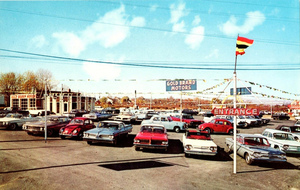
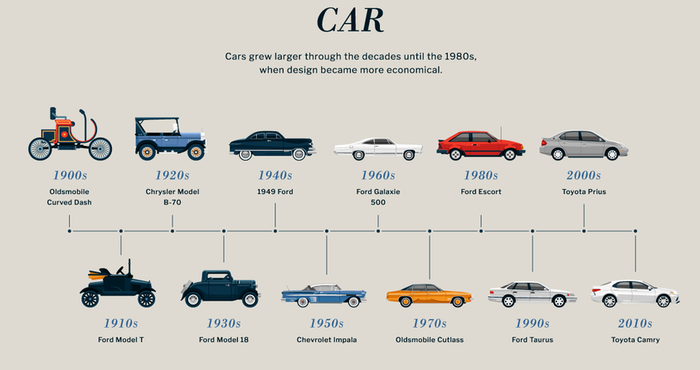
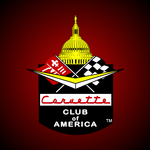
.jpg)
